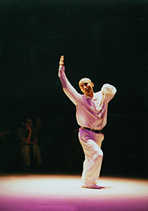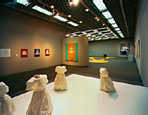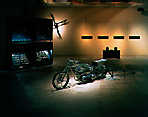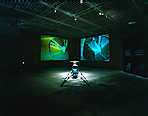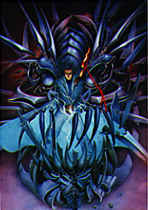
|
|
Oct. 22, 1996
|
Art Watch Index - Oct. 15, 1996
![]()
<<Improvisations 2>>
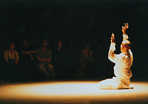
Toru IWASHITA <<Improvisation>>
Butoh Dance | Sankaijuku http://www.bekkoame.or.jp/ ~kasait/butoh/butoh-e1.htm
MAKIGAMI's Home Page
|
A Pure Dance Expressing the "Relationship"
The Park Tower Hall in Shinjuku, Tokyo, known for their continuous production of ambitious dance programs, has produced IWASHITA Toru's <<Improvisation 2>>, a five-night program from August 24 to 28. IWASHITA, also a member of Sankaijuku, is a dancer exploring not only solo dancing but also "communication" with other artists through "improvisation" (he is also an art therapist in his practice of psychiatry). In this series of performances, he chose to join the following five artists: Mitsugu SUGIYOSHI, a sumie (monochrome brush painting) artist, Takamasa SEGI, a player of samponar and cena, Michihiro SATO, a Tsugaru jamisen(three-string Japanese lute) player, Koichi MAKIGAMI, a voice performer, and Setsuko YAMADA, a dancer. I saw their performance on the fifth night. Towards the creation of the "relationship" The stage was a long rectangular space with a full audience on both sides. At each end of the stage, two dancers started different dances, as if there was no "communication" between them. The audience, unable to capture the two dancers in their vision simultaneously, could not find any visual "relationship" between the two. However, from such a non-relational state, gradually something like a sign of a "relationship" started to appear for the dancers and the audience. After the dance meandered between <conjunction> and <disjunction>, the two dancers finally came to an "encounter". However, even after the encounter, between the contact/non-contact of their bodies, the two dancers performed a variety of motions, as if such motions differentiated the space between them. Or rather, this was more like a drama of a "relationship". Dancing the "floor" Then, suddenly, all the lights went out. In the semi-darkness, the sound of banging the shoes on the floor echoed. When we expected that this time, it was a dance consisting only of sound, the room became light again, revealing YAMADA sniffing the feet of IWASHITA, holding IWASHITA's legs between her thighs. Laughter rippled through the audience. In contrast to the first dance, which was a phenomenological exploration of body relations, what began was a flirtation between the creation of "meaning" and pursuit of formalism, with humor inserted sporadically. The grammar of expression in the dance was free and colorful, its pivot being the relationship between the body and the floor, with parts other than the sole touching the floor, such as in "lying down" and "sitting", seen rarely in the Western-style dance. Here again, a delicate pursuit of body movement of contact/non-contact, based on our cultural sensitivity to body contact with others, is made. The rediscovery of tools Then suddenly, YAMADA stepped down into the audience, sat in a seat, and took off her shoe to give it to IWASHITA. The next dance was performed over this shoe which was both a gift and tool. With the increase of more "theatrical" stage design recently in the world of dance, this minimal device of a shoe reminded us of the importance of the "tool". In this case, the importance of the "tool" in their communication, and the versatility/delicacy of the tool as a medium were re-established. Over the shoe which had become a <present=medium>, the dance of "gentleness", and the dance of "caring" took place, at times vigorously, and at times slowly. The performance, though it came quite close to it, never transcended the threshold of "sign language", remaining in the realm of a duo dance. With the two dancers bowing to each other and towards the audience, this painfully sensitive and pure dance of relationship came to an end.
[Takaaki KUMAKURA/
|
|
|
|
<<Botanical Art Museum - Plants That Heal the Mind>>
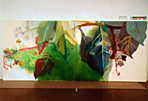
Chieko OSHIE
Yuki NAKAIGAWA Japan Horticultural Therapy Association(Japanese) http://www.bekkoame.or.jp/ ~takasuna/index.html
Meguro Museum of Art, Tokyo
Yoshinobu Nakagawa
Museum of Materia Medica
|
<<Botanical Art Museum - Plants That Heal the Mind>>
"Flowers and plants are silent existences," wrote May Satton, a reclusive essayist who wrote incisive essays, living alone in an old house in the countryside of America. Although she writes that "they give nourishment to our sensations besides the ears...", she continues to say that "even the sense of hearing may be included (in the healing)". It is certain that plants have the power that supercedes our five senses, and heals the human being, through their power to purify the air, power to provide food and medicine for us, through their beautiful color and form, and through their music played in the breeze as they sway. Today, we have become very sensitive to such powers plants have. Beyond an ecological sense, I believe our soul and spirit require plants. That is because, plants "coexist" more supply than animals, and they conceal a quiet yet passionate "vitality" for flourishing. More than the violent animal-like conflicts, the plant-like harmony has become an aspiration for our new lifestyle. A botanical garden for the eyes, the mind, and the intelligence <<Botanical Art Museum - Plants That Heal the Mind>> held at the Meguro Museum of Art, Tokyo, this summer, was an attractive exhibition for plant lovers, where various art works for encountering the attractive existences of plants (techniques of sensibility and manners of intelligence) were expressed according to the different characters of the artists.
If I were to name the works of the ten artists in my way, they would be as
follows:
"Herbal medicine", carrying the elegance of the wildlife All of the works were interesting, but I was particularly fascinated by the beautiful exhibition of "herbal medicine". Unlike the Chinese medicine pharmacies on the streets, dried flowers and plants were displayed quite artistically sending out the fragrance of elegance from the wildlife through the glass containers. They were, in a sense, a "visual medicine". They were like a door leading to witchcraft in which I am very interested, and to the world of the witches who are experts in medicinal herbs. As I left the room, I was thinking that maybe it is not such a bad idea to become a witch who can freely manipulate plants, secretly living in a hidden corner of the city.
[Chizuru MIYASAKO/
|
|
|
|
|
<<Ironic Fantasy
- Another World by Five Contemporary Artists>>

Chiezo TARO
Chiezo TARO
Yasutaka NAKANOWATARI
Yasutaka NAKANOWATARI
Mariko Mori - Reference Page http://www.artincontext.com/ listings/pages/artist/ 2/4v5x1a12/menu.htm
Fine Magazine Feature:
MOTORCYCLE ONLINE
|
<<Ironic Fantasy - Another World by Five Contemporary Artists>>
Works that reflect the environment of an age Out of the five artists (Takashi MURAKAMI, Chiezo TARO, Mariko MORI, Yasutaka NAKANOWATARI, and Yoshitomo NARA) who participated in the exhibition, 4 artists partake in their creative work in and out of Japan, thus, they have opportunities to present their works domestically and internationally. Also, four out of these five artists were born in the 1960's. The exhibition, spontaneously, is shaped by the factor of "generation" - or if "generation" is an unwelcome word, a certain frame of time in Japan. In short, this "frame of time" can be said to be the period under total American influence. The five artists gain/deconstruct their identity under the influence of pop culture that consists of comics, animation, pop music, motorbike and high technology. Their creative attitude of going back and forth Japan and overseas would not make sense without the "formation/deconstruction of their ego". Also, what must not be forgotten is that such a foundation for them to be able to express freely, the influence and relationship, erupted from the economic environment of the 80's in our country - a time when a highly developed consumption culture emerged, be it for the worse or the better. However, their expressions cannot be taken as a mere delayed Japanese version of pop art. Rather, we should realize the fact that post-war Japan was culturally "occupied" by America, and if the artists are expressing "pop" culture, that may be considered a "colonial pop culture" of the Fareast. Needless to say, I am not using this phrase in a negative way. The closed realm of "contemporary art" was established by ignoring such an influence, creating an institutional enclosure despite the fact that that influence was total. On the contrary, by actively recognizing the "negative factors" that restrict themselves, the expression of these five artists seem to have gained a freedom which is open to the outside world. "Freedom" that should be appraised
Looking at the works of these artists, I feel that the post-war Japan was
more hybrid and anarchic than we expected, thus, having been more free to
be connectable to all kinds of external realms. At times the activities
and the traits of these artists may potentially confuse the observer -
frequently traveling overseas, combining high culture and subculture,
mixing feminine and masculine elements, and traversing the element of race. Two works in particular are worth the attention in this exhibition; the futuristic installation by Chiezo TARO, which emits a strange radiance, and the installation by Yasutaka NAKANOWATARI that has both hard violence and lyricism. [Noi SAWARAGI/Art Critic]
|
|
|
|
<<Exhibition of the Original Pictures of
East Asian MANGA>>

Lin Min (China)
Lee Jaehak (South Korea)
Ma Wingsing (Hong Kong)
Yu Sulan (Taiwan)
Iwaki Meisei University Home Index http://www.iwakimu.ac.jp/
|
A report on the <<Exhibition of the
Original Pictures of East Asian MANGA>>
Beginning September 1, a month-long exhibition of the Original Pictures of East Asian MANGA was held at Iwaki City Art Museum in Iwaki city, Fukushima Prefecture. This is one of the main events for the East Asian Manga Summit '96. The Summit was also held for 3 days in Tokyo, together with symposiums and autograph sessions. At Iwaki, besides the exhibition of the original cartoon pictures, the citizens' gallery and a symposium was held as part of the "Manga College" held at Iwaki Meisei University, and it seemed that the event at Iwaki was the core event for the Summit. I would like to report and comment on my visit to Iwaki during which I looked at the various events. Iwaki City Art Museum has been collecting modern artworks, mainly centering on pop art. This is, therefore, one of the most suitable places to exhibit over 1,300 cartoon originals. Many families came to see the exhibition, and it had become a pop (popular) art exhibition in the true sense of the word. Difficulty in exhibiting long story comic books In terms of the content, there were some issues in the exhibition that could be considered as issues of the future. The exhibition included pieces by 100 Japanese cartoonists and 210 Asian cartoonists from 4 countries (regions), China, Taiwan, Hong Kong and South Korea, totaling to works contributed by 310 cartoonists. All of them were comic books with a relatively long story (story comic books), and not one-page/frame satiric cartoons we find in the newspapers. Up until this event, most of the international cartoon exhibitions featured one-page/frame cartoons, and this exhibition indicated the changes which took place with the age. Similar to Japan where story comics dominate over one-page cartoons, in the East Asian countries, story comics seem to be popular mainly among young people and children. Although explanatory boards on present situations and brief histories of cartoons in each country and region were displayed, the understanding would have been deeper if there were accompanying plates to supplement the explanation. More than that, I felt irritation in representing a long story comic with only one or two pieces of original pictures. Unless one had read the work, the attraction of the comic will not come through merely from one or two pages of original pictures. Unlike cartoons or comic strips, story comic books have a difficulty in such a presentation. This type of cartoon/comic exhibitions will probably increase in the future, and solutions to such a problem must be considered. The great influence of Japanese comic books This was my first experience to see East Asian cartoon originals in an exhibition of such scale. The strongest impression I had was how great the influence of Japanese comic books was on other countries. The exhibition featured only authentic pieces and there were no notorious pirate versions or bandit versions (Koreans call stealing popular cartoon characters from other comic books to use in different stories as "bandits"). Nevertheless, I saw a number of characters quite resembling those by the Japanese cartoonists, such as Katsuhiro OTOMO, Shuho ITABASHI, Hisashi EGUCHI, Takeshi KANDA or Akira TORIYAMA. This kind of resemblance is not necessarily something to accuse them of, because even young Japanese cartoonists receive great influence from their senior cartoonists on their styles. Rather, it was a pleasant surprise for me to see that Manga, an expression which went through a unique developement in Japan, to have become so widely popular overseas. It was interesting to see that there were cultural differences on the influence received from the Japanese cartoonists. It seemed that influence of some cartoonists popular in Japan,such as Shigeru MIZUKI, Kazuo UMEZU, Yoshiharu TSUGE, or Shinji NAGASHIMA, could not be seen at all. Also, there appeared no influences from gag comic books from Japan. The above is said to be true of Hong Kong, Taiwan and South Korea, but the situation is a little different in China. Probably due to the fact that China has a socialist regime, only a few Japanese comic books are brought into the country, and there must be restrictions on the expression. Overall, the pictures and the framing are old -fashioned. I also paid a visit to the site at Iwaki Meisei University. Because it was located far from the center of the city, there were not so many visitors. Still, in a talk show for animated cartoon maniacs hosted by Toshio OKADA and Syunichi KARASAWA, some 50 audiences gathered, enjoying the maniacal discussion that took place. [Tomofusa KURE/Critic]
|
|
|
|
|
|
|
|
|
Oct. 22, 1996
|
[home]/[Art Information]/[Column]
Copyright (c) Dai Nippon Printing Co., Ltd. 1996
Network Museum & Magazine Project / nmp@nt.cio.dnp.co.jp
